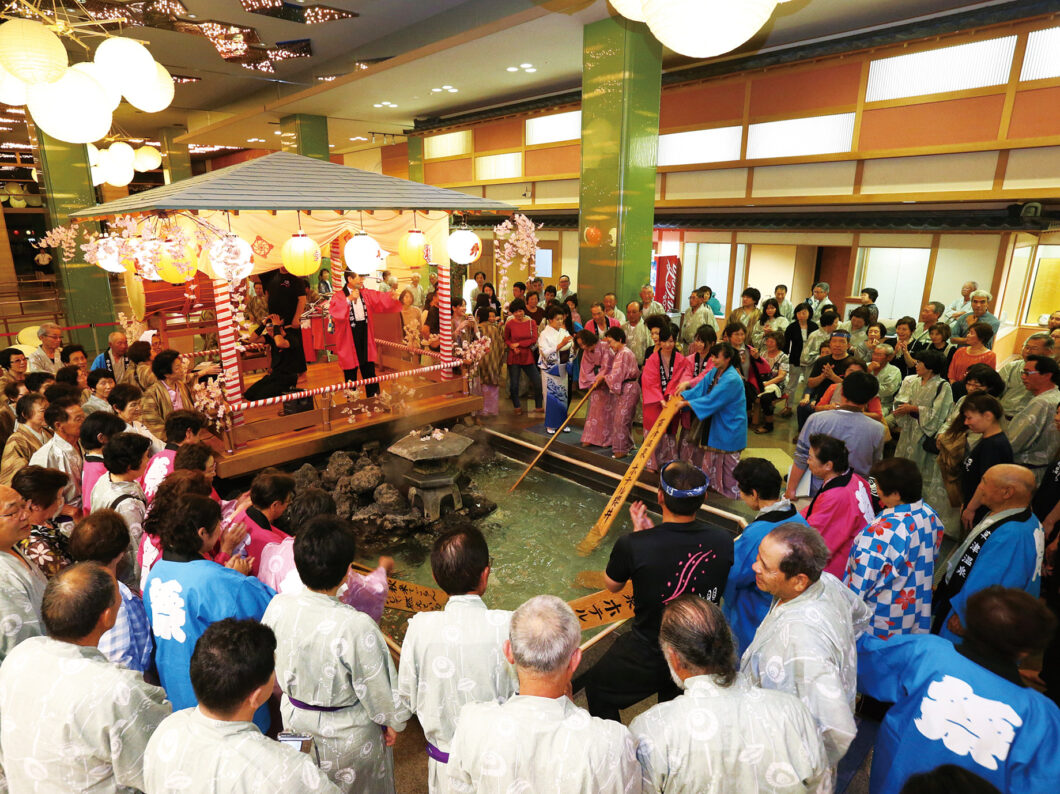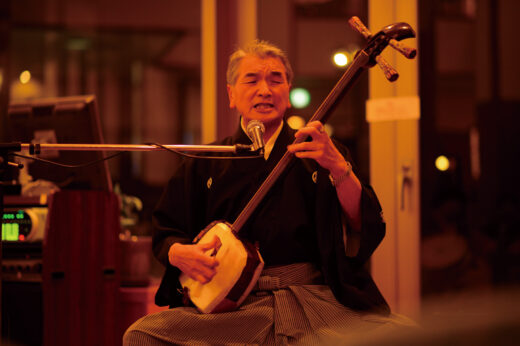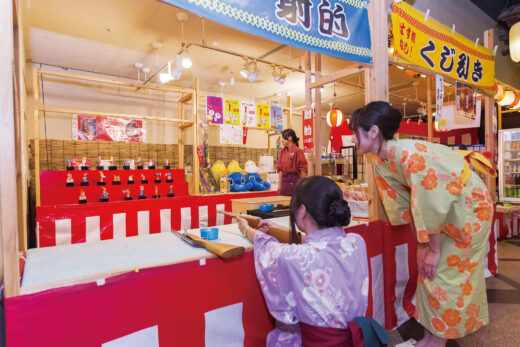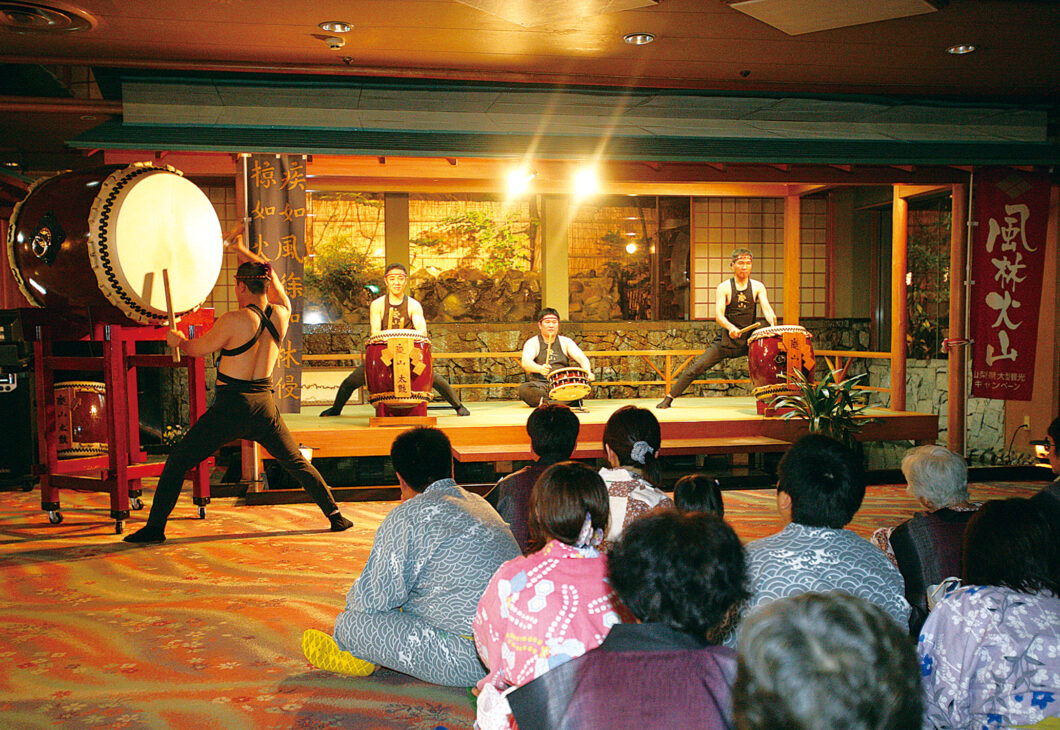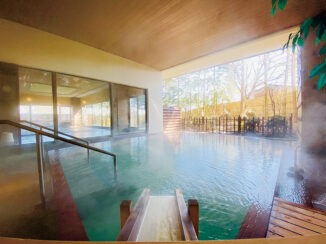Featured
INDEX
Enjoy the deer dance, Tsugaru shamisen, festivals, Yumomi show and Taiko drum show with a smile on your face.
Many five-star inns are popular for the way they make your night of travel the most exciting one yet. Although not featured in this magazine, Musubi no Yado Airinkan in Shinnamari Onsen Prefecture, offers a limited-time event at the festival square Nanbu Bayashi, where you can enjoy the local performing art of Shika Odori, ancient Kagura dance, Tsugaru shamisen playing, and a Tohoku folk song show. Airinkan is an inn blessed with the natural beauty of the hometown upstream the Toyosawa River. Nanbuya Kaisenkaku and Hotel Grand Mer Sankaiso in Asamushi Onsen Onsen, Aomori Prefecture, hold powerful Tsugaru shamisen live performances every night.
The Nanbuya Kaisenkaku is an ocean view inn overlooking Mutsu Bay, and Hotel Grand Mer Sankaiso is known for its natural hot springs called "fossil seawater" and all-inclusive accommodation.
The Flower & Garden Hotel Mori no Kaze Kaze Oushuku-yado in Shizukuishi, Iwate Prefecture, excels at creating a nostalgic atmosphere for hospitality. Every night, the staff hold events in the festival plaza, which recreates the lively atmosphere of childhood festivals, and the fairground next to the stage is lined with stalls, shooting galleries, lotteries, and more. In the folk song show, the entertaining talk, which includes the regional Iwate accent, fills the entire plaza with laughter.
Also, Hotel Sakurai is the only hotel in Kusatsu, Gunma Prefecture, the most popular hot spring resort, where you can enjoy the Yumomi Show inside the hotel. Everyone can try Yumomi to the tune of Kusatsu folk song "Come to Kusatsu at least once♪". Next comes the Sakura Taiko Show. The staff will play original music that evokes the image of spring in full bloom and cherry blossoms in full bloom, putting their heart and soul into every beat. It is a dynamic Japanese drum show that resonates, roars, and shakes the soul.
There is another inn where you can enjoy a taiko drum show performed by the staff. It is "Hanayagi no Yado Keizan " , located a 5-minute walk from Isawa Onsen Station in Yamanashi Prefecture. The " Keizan Taiko Show" is held on the stage at the back of the lobby. You are sure to be captivated by the taiko drums, which are unique to Kai Province and evoke the stillness and movement of Fuurinkazan.
Japanese festivals and traditional performing arts are also an option at five-star accommodations
When traveling, people want to experience the history and culture that lives on in the place they are visiting. In this age of inbound tourism, the motivation seems to be the same for foreign visitors to Japan, and in a survey on what they would like to experience in Japan, many cited "enjoying festivals and traditional events." There are said to be around 300,000 festivals in Japan. According to the Dictionary of Japanese Festival Culture (Tokyo Shoseki), there are 1,051 solar calendar festivals and 133 lunar calendar festivals, for a total of 1,184 festivals held nationwide.
Among Japan's intangible cultural heritage are various traditional events that can only be seen in a certain region at a certain time, such as Oku-Noto Ae-koto, Hayajimine Kagura, Akiu rice planting dance, Dainichido Bugaku, Daimokutate, Ainu traditional dance, Kumiodori, Mibu Hanataue, Sada Kamino, Yama, Hoko and Yatai events, Furyu dance, etc. Digressing from the subject, following on from "Traditional Japanese Food Culture" being registered as an intangible cultural heritage by UNESCO, it seems that UNESCO has also begun deliberations to register "traditional sake brewing."
There are five-star inns located all over Japan. Enjoying festivals and traditional performing arts might be a motivating factor when choosing a place to stay. With that in mind, we have compiled the dates of some of the most well-known festivals in Japan in the table on the left. We hope you will find this useful.
Representative festivals of Japan (limited to prefectures and regions with 5-star hotels)
| Festivals | Event period |
|---|---|
| Sapporo Snow Festival (Hokkaido) | In principle, February 5th to 11th |
| YOSAKOI Soran Festival (Hokkaido) | Usually mid-June |
| Aomori Nebuta Festival (Aomori) | Usually held from August 2 to 7 |
| Hirosaki Neputa Festival (Aomori) | Usually held from August 1st to 7th |
| Chagu Chagu Umako (Iwate) | Usually the second Saturday of June |
| Morioka Sansa Festival (Iwate) | Usually held from August 1st to 4th |
| Yamagata Hanagasa Festival (Yamagata) | Usually held from August 5th to 7th |
| Nihonmatsu Lantern Festival (Fukushima) | The first Saturday, Sunday and Monday of October |
| Iizaka Fighting Festival (Fukushima) | Usually from late September to early October |
| Sendai Tanabata Festival (Miyagi) | Usually held from August 6th to 8th |
| Sendai Aoba Festival (Miyagi) | Usually the third Sunday in May and the Saturday before |
| Nanso Satomi Festival (Chiba) | Usually the third Saturday of October |
| Onbashira Festival (Nagano) *Once every 7 years | Once every seven years from April to early May |
| Takayama Festival (Gifu) | Usually held on April 14th and 15th, and October 9th and 10th |
| Gifu Gujo Dance (Gifu) | 32 nights from mid-July to early September every year |
| Etchu Yao Owara Bon Festival (Toyama) | September 1st to 3rd every year |
| Kanazawa Hyakumangoku Festival (Ishikawa) | Three days usually including the first Saturday in June |
| Saio Festival (Mie) | Only one day in early June each year |
| Nachi Fire Festival (Wakayama) | July 14th every year |
| Hiroshima Flower Festival (Hiroshima) | Usually held from May 3rd to 5th |
| Izumo Taisha Grand Festival (Shimane), Izumo City | Usually held from May 14th to 16th |
| Uwajima Ushi-oni Festival (Ehime Prefecture) Uwajima City | Every year from July 22nd to 24th |
| Awa Dance (Tokushima) Tokushima City | Usually held from August 12th to 15th |
| Yamaga Lantern Festival (Kumamoto) | Usually held on August 15th and 16th |
| Land of Fire Festival (Kumamoto) | Usually held from August 2nd to 4th |
| Nagasaki Kunchi Festival (Nagasaki) | Usually held from October 7th to 9th |
| Nagasaki Lantern Festival (Nagasaki) | Usually from the 1st to the 15th of the first month of the lunar calendar |
| Ohara Festival (Kagoshima) | Usually held on November 2nd and 3rd |
*The dates may vary from year to year, so please check for details.

